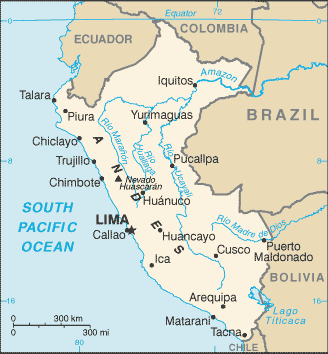 The process of working out implementing regulations for Peru's new medical marijuana program is now officially in extra innings, extending beyond the 60-day window that opened with the signing of the law in November. Advocates are still watching to see whether homegrown will be permitted or just lab-grown, and what constitutes a "laboratory." Meanwhile, despite this tentative progress, the cannabis-growing heartland of the Norte Chico continues to see big militarized police raids on campesino cultivation.
The process of working out implementing regulations for Peru's new medical marijuana program is now officially in extra innings, extending beyond the 60-day window that opened with the signing of the law in November. Advocates are still watching to see whether homegrown will be permitted or just lab-grown, and what constitutes a "laboratory." Meanwhile, despite this tentative progress, the cannabis-growing heartland of the Norte Chico continues to see big militarized police raids on campesino cultivation.
When Peru's medical marijuana law was signed by President Pedro Pablo Kuczynski on Nov. 16, it was hailed as a victory by advocates—especially the mothers of the Buscando Esperanza (Seeking Hope) collective, who were producing cannabis for their ailing children. The police raid on their operation in a Lima apartment just over a year ago is what forced the issue into the public eye and ultimately resulted in the legislation. But members of the collective may yet face prison time. And the text of the law is vague on whether homespun operations like the one they were running will actually be permitted.
This was supposed to be clarified in enabling legislation for the act, which is to provide a regulatory framework for the program's implementation. Officially, this was to be completed with 60 days. But it was already early February when lawmakers and the Health Ministry officially announced formation of a joint commission to hash out the regs. A month later, the process has still not yeilded results.
Law 30681, by its official designation, is slightly ambiguous on the question of homegrown. Technically, cultivation is only permitted in "laboratories," but this is not actually defined in the text—leaving open possibilities for patient collectives such as Buscando Esperanza. With formation of the joint commission, Health Miniser Abel Salinas Rivas sounded the predictable note of caution. "We have to be careful and secure in the correct uses of cannabis," he was quoted in the official government daily El Peruano. Alberto de Belaunde, Law 30681's co-sponsor and the key legislator on the joint commission, was not quoted.
Throughout the process of crafting the legislation, Buscando Esperanza pressed for the right to autocultivo, or homegrown. They repeatedly held marches outside the congress building, chanting "¡Autocultivo es la solución, por eso decimos no a la importación!" (Homegrown is the solution, say no to importation!), as reported in Perú21. Ricardo Soberón, Peru's foremost drug policy reform advocate who helped draft the law, also spoke out in the media in favor of homegrown provisions.
With the process officially in extra innings, advocates are still waiting to see whether the regulations will allow patients to cultivate in regulated collectives—or even have access to herbaceous cannabis, something else the text of the law is ambiguous on.
Luis Gavancho, Peru's premier cannabis activist and one of the three facing charges in the Buscando Espernza case, was reached in Lima by Cannabis Now. He said he expects the regulations to be finalized within two weeks. And what is the justification for being in violation of their own legislative process by taking so long? "When the state violates its own regulations, they never justify it," replies Gavancho, leading light of the advocacy group Legaliza Perú.
Meanwhile, pressure has certainly not been lifted on the small campesino cultivators. This is an especially pressing question in the Norte Chico area, the strip of coast and inland mountains extending some 500 kilometers north from Lima. The Norte Chico has emerged as Peru's heartland of outdoor cultivation by the local peasantry in recent years, and has been aggressively targeted for eradication by authorities.
The latest big haul ironically came just as formation of the joint commission on Law 30681 was announced last month. Peru's militarized National Police announced the seizure of 100 kilos of cannabis at a pueblo in Áncash region, at the northern tip of the Norte Chico. The stuff had apparently been recently harvested in the campesino community of Monte Sarumo, outside the port city of Chimbote. Six locals were arrested, and two rifles confiscated, El Comercio reported.
The six have not been formally charged but are being held in "preventative detention" while an investigation is open into their presumed grow op, El Comercio reported two weeks after the initial raid. The practice of "preventative detention" is another common abuse of Peru's "drug war." And while the target has traditionally been coca growers and traffickers in the high jungles on the remote eastern slopes of the Andes, a new target is increasingly the cannabis cultivators on the Pacific-facing side of the mountains in the Norte Chico.
Alas, even if the enabling legislation for Law 30681 affords greater freedom for patient collectives to auto-cultivate, it will probably do nothing to lift the pressure on the peasant cannabis-growers of the Norte Chico—unless they can be integrated into a legal medicinal market. But that is clearly a long way off.
Cross-post to Cannabis Now
Graphic: Perry-Castañeda Library Map Collection







Recent comments
5 days 8 hours ago
4 weeks 5 days ago
8 weeks 4 days ago
12 weeks 4 days ago
13 weeks 2 days ago
23 weeks 2 days ago
27 weeks 3 days ago
28 weeks 3 days ago
28 weeks 3 days ago
49 weeks 4 days ago